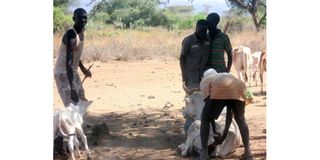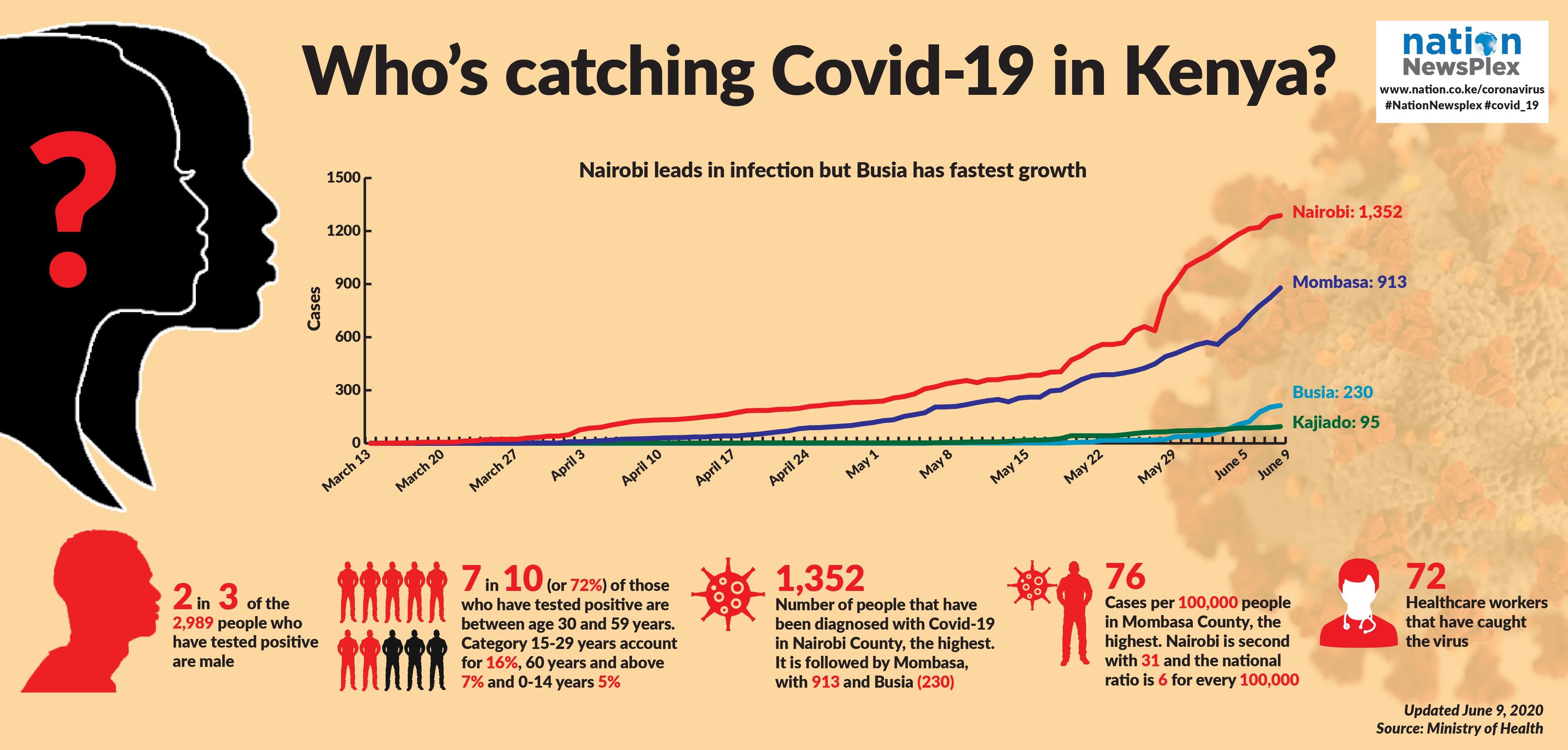Premium
Hunger stalks four million Kenyans as drought set to worsen
DESIGN | ALICE OTHIENO
What you need to know:
- Timely action by the government and partner organisations may have saved thousands of children from retarding,
- In Mandera, nearly one third of the county’s population is malnourished. The malnutrition rates have risen above the emergency threshold of 15 per cent in many parts of the country.
- In marginal agricultural areas, which include the south east and coastal parts of Kenya, households will likely remain stressed (IPC Phase 2) until July 2017
Up to four million Kenyans could be in need of food aid in the coming few weeks, and the situation could get even worse if the long rains fail, reports by relief organisations show.
The finding means that relief efforts by the government will have to be sustained in order to prevent what is already a disaster from getting worse.
In a statement sent to Nation Newsplex Thursday, the Kenya Red Cross announced that three million people currently need food assistance according to government estimates, and the number could rise to four million in the coming weeks.
But some good news is also emerging. Timely action by the government and partner organisations may have saved thousands of children from retarding, according to the United Nations Office for the Coordination of Humanitarian Affairs (OCHA). But it could require much more to wipe out the lasting effects of low diet among children.
“The urgent action we need is getting the treatment to the kids who are malnourished. That is happening. We are working with the government and agencies like United Nations Children’s Emergency Fund (Unicef) to make sure that the nutrition supplements are getting to the kids,” Ms Aida Mengistu, the head of the OCHA Regional Office for Eastern and Southern Africa, said today, on the sidelines of a meeting organised by the Intergovernmental Authority on Development (IGAD) in Nairobi this week.
The current drought may not have severe effects as that of 2011 when 10 million people in the Horn of Africa faced famine and more than 200,000 died from hunger, the IGAD meeting heard.

From left: Principal Secretary in the State Department for Special Programmes Ms Jospheta Mukobe, IGAD Executive Secretary Amb. Mahboub Maalim and H.E. Dr. Workneh Gebeyehu, Minister of Foreign Affairs of Ethiopia and Chairperson of the IGAD Council of Ministers during a consultative meeting on drought preparedness, response and recovery held at Hotel Intercontinental hotel on March 31, 2017. PHOTO | JEFF ANGOTE
“We are focusing on the vulnerable. In the food we have purchased, a lot of it is meant to replenish their health. These are special foods targeting pregnant, lactating mothers and children. It is a nutrition component that we hope can reverse this trend,” Planning PS Josepheta Mukobe told Nation Newsplex
STEADILY WORSE
The Meteorological Department is predicting that rainfall will be depressed between the months of March and May, normally Kenya’s long rain season.
Data reviewed by Newsplex shows that the food emergency has gotten steadily worse. According to a recently released government report, there are now 2.6 million people in need of food, double those who were in need in August 2016. Of that number, 42 per cent, or 1.1 million are children.
In Isiolo - the worst hit county by percentage - 83,900 or more than half the county population (55 per cent) is at risk. Other counties with high proportions of their populations at risk include Marsabit, Tana River and Samburu (all 44 per cent) and Lamu (40 per cent).
Another group of counties has between one third and a quarter of people in need. They include Wajir (32 per cent), Garissa (29 per cent), Mandera (28 per cent), and Turkana, Kwale and Nyeri (all 25 per cent).
These statistics are contained in the Short Rains Assessment Report published in February 2017 by the Food Security Steering Group (FSSG), a grouping of Kenyan government departments and international organisations.
More information is also contained in the report of the Kenya Flash Appeal, which seeks to raise Sh17 billion.
More than four out of five of the 2.6 million in need by February (2.2 million) are classified as being in crisis while the remainder are considered stressed. That classification is done according to the Integrated Phase Classification, an internationally accepted benchmark used to measure the severity of food emergencies.
SEVERE ACUTE MALNUTRITION
Half the people affected are in seven counties, which are Turkana, Kwale, Mandera, Kilifi, Kitui, Makueni and Wajir. Turkana has the largest number of people affected, with 276,200 at risk, a quarter of its population.
Across the country, 23 arid and semi-arid counties are at risk. Thirteen of them, or just over half, depend on livestock, while another 10 depend on agriculture in marginal or less fertile areas.
According to Unicef, more than 100,000 children aged under five years need treatment for severe acute malnutrition. A total of 343,559 children in arid and semi-arid counties require treatment for acute malnutrition, with 268,549 suffering from moderate acute malnutrition and 75,010 suffering from severe acute malnutrition.
That is an increase of 16 per cent from July 2016, when there were 294,330 acutely malnourished children, 233,700 moderately malnourished and 60,000 severely malnourished. There are also 37,223 pregnant and breastfeeding women, constituting an increase of 26 per cent over August 2016.
In Mandera, nearly one third of the county’s population is malnourished. The malnutrition rates have risen above the emergency threshold of 15 per cent in many parts of the country.
Despite a low prevalence of acute malnutrition in Nairobi, the capital city has the second highest number of malnourished children in Kenya, according to Unicef. These children, who are mainly in informal settlements, serve to highlight deprivation in urban areas.
RELIABLE WATER SUPPLIERS
The drought has caused serious disruptions to education. According to Unicef, 175,000 children are not attending primary and pre-primary school as a result of the food shortage in 10 counties. The school attendance of girls has been particularly affected with a reduction of almost 50 per cent in some counties. Some schools have closed as communities have migrated due to drought and lack of school meals.

Residents of Barwessa in Baringo North help an emaciated cow to stand on January 8, 2017. The dry spell has affected animals, which are dying due to lack of water. PHOTO | CHEBOITE KIGEN
The government has taken measures to help mitigate the fallout. President Uhuru Kenyatta declared the drought a national disaster on February 10, 2017. Since then, the government has allocated Sh11 billion for various programmes, from February to April.
On March 19, the Principal Secretary in the State Department of Irrigation, Dr Patrick Nduati, told Newsplex that the government was digging 65 boreholes, erecting 140 water pans and building 57 large dams to help rural dwellers get reliable water supplies.
Yesterday, Treasury Cabinet Secretary Henry Rotich, in the 2017 Budget Statement, zero-rated Value Added Tax on maize, wheat and bread in order to help Kenyans cope with rising food prices. He also allowed the importation of maize duty free for the next four months.
The importance of this assistance is made clear by predictions by the FSSG, which make for sobering reading. Household food consumption is expected to deteriorate again from July onwards, with more households likely to slide back into crisis (IPC Phase 3) from August 2017.
SELL IMMATURE CROPS
In pastoral areas, food security is expected to decrease, with grazing areas recovering poorly from the long rains, because of higher than normal temperatures on the land surface.
Given the long distances that animals must walk for pasture and water, the animals will be emaciated and earn less at markets. Owners, who rely on the animals for income will therefore have less to eat.
In marginal agricultural areas, which include the south east and coastal parts of Kenya, households will likely remain stressed (IPC Phase 2) until July 2017, partly because the long rains are not the main season for crop production there.
According to the OCHA report, there are dire consequences for not acting. First, the people who are affected by drought often try to cope in destructive ways. For example, they are likely to sell immature crops, eat the seeds they have preserved for planting the next season, sell breeding animals that could earn them more income, or take their children out of school and send them, and other family members, to beg.
People facing drought can also eat smaller food portions, or restrict the number of meals they eat. If things get worse families take more risks, including getting into severe debt to buy food, engaging in prostitution or stealing, or migrating to new places.
According to OCHA, previous famines show that even if half your herd survives, it can take a minimum of two to four years for pastoral and agro pastoral to recover. It can take up to a decade for most of the families affected to restore herds to pre-famine levels. The loss of herds could ultimately increase migration to cities.
On March 28, the Kenya Red Cross raised its fundraising target to Sh2.6 billion, from Sh1billion. The money will assist one million people, almost a threefold increase from the 340,786 announced in January.





